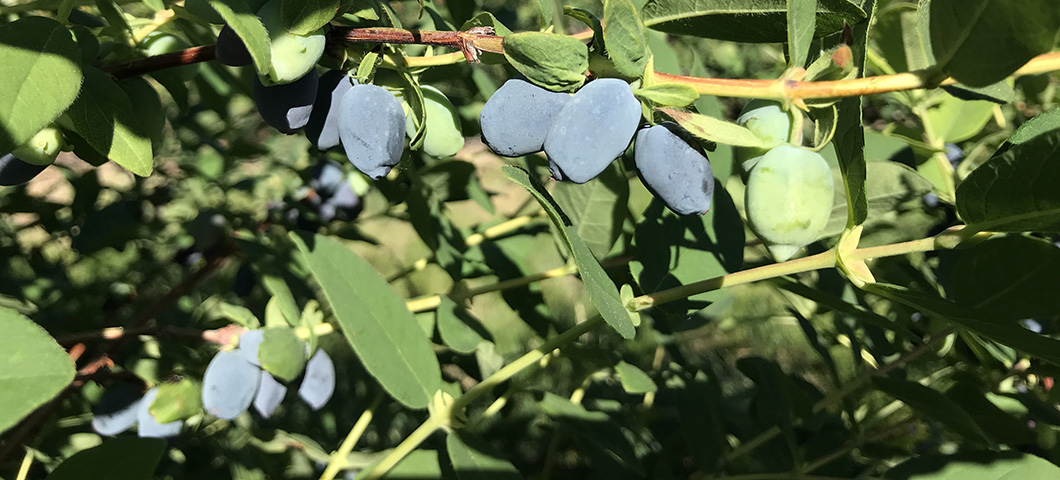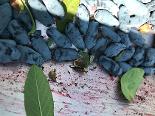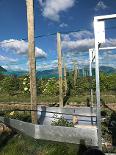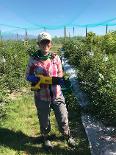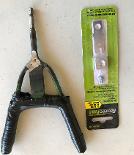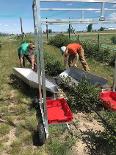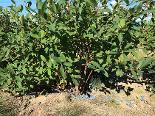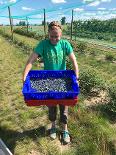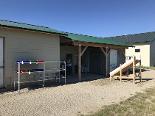Labor Estimates for Small-Scale Haskap Production
Introduction
Labor is one of the highest costs in fruit production, typically representing 80% of annual costs. Little information is available for small-scale Montana haskap growers to estimate labor costs for either hand- or mechanical-harvest. To address labor harvest logistics and ensure markets for all fruit, both methods can be employed with the same plants in one season by first hand-harvesting and following up with mechanical harvest for the remaining fruit.
This article reports on a study of fruit harvest and cleaning labor done in summer 2020 at MSU-WARC. We evaluated hand-harvest of fresh market haskaps and mechanical harvest and initial cleaning of processing-quality haskaps (e.g. for freezing or making wine or jam). We also estimated total return per plant and per acre. Estimated returns per acre do not include overhead costs (land costs, equipment costs) or plant maintenance (fertilizing, weeding, irrigation, and pruning).
In addition, a vertically integrated operation where the grower uses their own fruit to make jam, wine, or another value-added product may ultimately realize greater returns per pound of processing-quality fruit than estimated here. We know of one Montana grower who has sold frozen haskaps for $12 a pound, so our estimates for the value of processed fruit may be low or prices may vary with the marketing acumen of the grower. Growers will need to conduct their own market research and develop appropriate marketing strategies.
Study Summary
Hand-harvest of fruit for fresh market
Estimated labor time and costs per acre for hand-harvested fresh market haskaps were 2,300 hours or $22,973 (employees paid $10 per hour). This number represents only harvest costs and not other labor involved in haskap production (e.g. weed control, pest management, pruning). Price estimates from our consumer study indicate that profitability potential is much higher for fresh market fruit than for processing-quality fruit—if the required labor is available (considering the several week harvest window) and a viable market exists.
Table 1. Gross return minus hand-harvest labor* costs
|
Gross per acre
|
|
|---|---|
|
Low end
|
$87,421.14
|
|
High end
|
$128,819.04
|
* labor estimates include only harvest and minimal cleaning prior to freezing
Small-scale mechanical harvest of fruit for processing market
For mechanical harvest, we used an over-row, small-scale mechanical harvester (the Indigo Super Tech jaseur des champs (waxwing) harvester) and a modified reciprocating saw for shaking fruit from the bushes (see study details, photos, and video, below). Labor time and costs were much lower than fresh market, at 269 hours or approximately $2,695 per acre (employees paid $10 per hour). These numbers represent only the harvest and minimal cleaning labor prior to freezing the fruit, and do not include the other labor involved in haskap production (e.g. weed control, pest management, pruning).
Table 2. Gross return minus mechanical-harvest labor costs
| Gross per acre* | |
|---|---|
| Low end | $12,376.32 |
| High end | $28,166.82 |
* labor estimates include only harvest and minimal cleaning prior to freezing
Hand-Harvest for Fresh Market Fruit - Study Details
Note: One of the challenges of fruit production for the fresh market is that the marketing window for the product is relatively short due to the perishability of the fruit. However, our data (unpublished) suggest that fresh haskaps have a relatively long shelf-life when stored properly (high humidity [98% relative humidity] and cold temperatures [33-34 F]). Unless harvested fruit is immediately sold or processed, it is essential to invest in proper cold storage for fresh fruit and freezer storage for processing-destined fruit.
Labor timing study for hand-harvested fresh market fruit
Seven hand-harvest workers participated in this study in our ‘Aurora’ haskap block on 7/6/20. Study participants self-categorized their picking experience as less than one month, 1 to 6 months, or more than 6 months. One person had less than one month experience (their timings are not included in the study summary), 2 people had 1 to 6 months, and 4 people had more than 6 months hand-harvesting experience. Pickers were instructed to select only quality fruit for fresh market and self-record their time to hand-harvest six, 6-oz containers of haskaps.
Experience nominally affected picking rate (no statistics performed due to the small sample size), with the least experienced picker averaging 8.56 decimal minutes per 6-oz container (n=1), pickers with 1 to 6 months averaging 5.16 decimal minutes per container (n=2), and those with more than 6 months of experience averaging 4.82 decimal minutes per container (n=4). We did not time set-up for harvesting, which would include procuring, labeling, and organizing the clamshell containers, cleaning and organizing the trays for carrying clamshells to and from the orchard, or transporting and organizing fruit at the point of sale. The price points of $4 to $5.50 per container are based on our consumer study.
Each clamshell averaged about 6.1 oz of fruit (by weight) (n = 6, pulled at random from harvested fruit). Average annual yield of our ‘Aurora’ variety in 2019 and 2020 was 7.4 lb and 7.1 lb per plant, respectively. Using these figures, a grower could average nineteen, 6-ounce clamshells of fruit per plant, assuming all fruit were fresh-eating quality. We did not pick the shrubs “clean” in this study as each picker picked just six, 6-ounce containers (picking shrubs “clean” would take longer, as some fruit tends to be towards the interior of the shrub and not as easily reached).
Our consumer study of members of a large CSA indicated they would pay between $4 and $5.50 per six-ounce clamshell in Montana (these people are attuned to supporting local growers, so may also be the type to shop at farmers’ markets). In our 'Aurora' block, plants are 3’ apart in-row and 10’ apart between rows (1,452 plants per acre). The following summary uses the suggested prices of $4 or $5.50 per six-ounce clamshell of fresh ‘Aurora’ haskap fruit.
Table 3. Labor and return estimates for hand-harvest of fresh market-quality fruit
| Sale price per lb - low end | $10.53 |
| Sale price per lb - high end | $14.47 |
| Gross return per plant - low end | $76.03 |
| Gross return per plant - high end | $104.54 |
| Gross return per acre - low end | $110,394.42 |
| Gross return per acre - high end | $151,792.32 |
| Labor time per lb (decimal hours) | 0.22 |
| Labor time per plant (decimal hours) | 1.58 |
| Labor time per acre (decimal hours) | 2,297.33 |
| Labor cost per plant (at $10 per hour) | $15.82 |
| Labor cost per acre (at $10 per hour) | $22,973.28 |
Table 4. Gross return minus hand-harvest labor costs for fresh market-quality fruit
| Gross per acre | |
|---|---|
| Low end | $87,421.14 |
| High end | $128,819.04 |
Mechanical Harvest for Processing-Quality Fruit - Study Details
Fruit-harvesting and -cleaning methods and equipment
See photos and watch a video below demonstrating our mechanical-harvesting and -cleaning process.
Harvests occurred in the 'Aurora' block in the mornings (to avoid fruit deterioration during the heat of the day) of 7/13 and 7/14/2020. The block was divided into rows (n=4), with row 1 on the west side, and sections (n = 3), with the posts supporting the bird net being the section dividers, and section 1 starting on the south end. See the bird netting setup in the above linked video.
Fruit were shaken from the plant using a reciprocating saw with a custom-made “Y” attachment. As fruit were harvested, they dropped into the waxwing collectors. Each plant was harvested by two people—one operating the saw, the other assisting with that process as needed, and both emptying the fruit from the waxwing collectors into trays and moving equipment to the next plant. Harvesters aimed to fill each tray no more than 2 inches deep with fruit to prevent crushing fruit near the bottom.
Trays of fruit were then transported to the cleaning area, where each tray was emptied onto the upper end of a custom-made chute. The person standing at the lower end of the chute used a leaf-blower to rough-clean the fruit as it rolled down the chute into the collection bin. This process removed leaves, sticks, insects, and dirt clods from the harvest. Fruit were then transferred to a clean tray for freezing. The fruit were not washed at any stage.
Table 5. Harvest and fruit cleaning equipment costs
| waxwing harvester | $2,000 |
| Reciprocating saw, batteries, & attachments |
$300 |
| Cleaning chute materials | $100 |
| Leaf-blower & batteries | $250 |
| Stackable fruit trays | $12 ea |
Harvesting and initial cleaning timed labor study
We recorded harvest time per filled tray as the time it took to shake fruit from the plants. The stopwatch was paused when the waxwing was emptied into the tray and at section ends where the waxwing needed to be lifted and moved around the post. Times were also not recorded for: transporting fruit-filled trays to the cleaning area and cold storage, washing and sanitizing trays, transferring fruit to clean trays for refrigeration and subsequent freezing, quality-control prior to bagging, pouring fruit into bags, or weighing bags and transferring bagged fruit to the freezer. We did not collect yield data per plant as we had harvested berries from the plants for several previous research projects.
Table 3. Labor and return estimates for mechanical harvest of processing-quality fruit
| Sale price per lb - low end | $1.50 |
| Sale price per lb - high end | $3.00 |
| Gross return per plant - low end | $10.88 |
| Gross return per plant - high end | $21.75 |
| Gross return per acre - low end | $15,790.50 |
| Gross return per acre - high end | $31,581.00 |
| Harvest labor | |
| Time per lb (decimal hours) | 0.03 |
| Time per plant (decimal hours) | 0.19 |
| Time per acre (decimal hours) | 269.53 |
| Cost per plant (at $10 per hour) | $1.86 |
| Cost per acre (at $10 per hour) | $2695.32 |
| Cleaning labor | |
| Time per lb (decimal hours) | 0.01 |
| Time per plant (decimal hours) | 0.05 |
| Time per acre (decimal hours) | 71.89 |
| Cost per plant (at $10 per hour) | $0.50 |
| Cost per acre (at $10 per hour) | $718.85 |
| Harvest + cleaning labor | |
| Time per lb (decimal hours) | 0.03 |
| Time per plant (decimal hours) | 0.24 |
| Time per acre (decimal hours) | 341.41 |
| Cost per plant (at $10 per hour) | $2.35 |
| Cost per acre (at $10 per acre) | $3414.18 |
Table 4. Gross return minus harvest labor* costs
| Gross per acre | |
|---|---|
| Low end | $12,375.32 |
| High end | $28,166.82 |
* Labor for harvest and minimal cleaning prior to freezing
Video: "Harvesting Haskap Berries with a Kiddie Pool and a Reciprocating Saw"
A modified kiddie pool can be used instead of the waxwing harvester for lower-budget operations.
Fruit Harvest and Cleaning - Image Gallery
Use arrow keys or click (tap on mobile) at left or right edges of the photo to move through slideshow. Click outside the photo to exit slideshow.

